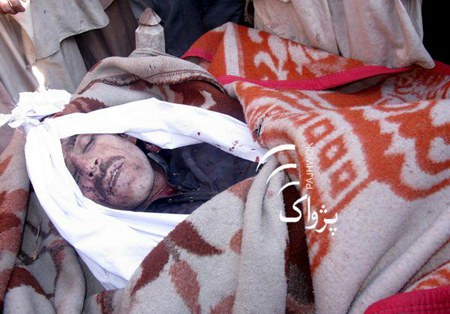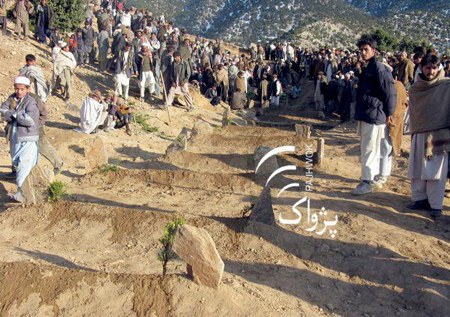RAWA News, February 2, 2009
Obama More Deadly for Afghan Civilians than Bush (in Jan 2009): “Change” Afghans Should Look Upon with Skepticism
Simple arithmetic reveals that the eleven days under the Obama clock were 18-50% more deadly for Afghan civilians than the twenty days under the Bush regime – Marc W. Herold.
by Marc W. Herold
The New Year’s first Afghan civilian killed by U.S/NATO action was a boy named Marjan (tr. Coral), killed on January 2nd. (1) ( #note )The boy had allegedly wandered into a prohibited area in the Deh-Sabz district of Kabul. Marjan was walking home with friends when “international forces” gunned him down. The occupation soldiers got out of a white vehicle, shot Coral and sped away. Marjan is only one of 73-88 civilian Afghans or tribal Pashtuns killed by the U.S/NATO occupation forces during January 2009. Three days later, eight Afghan women, two children and two civilian men were killed by Australian forces in the Chora district of Uruzgan Province.
Much official ado has been made in Washington D.C. and in the U.S. corporate press about how the new Administration will be taking far greater care as regards Afghan civilians. Data analyzed below for January 2009 suggests that the deadliness of the Afghan war for civilians under the Obama clock significantly exceeds that registered under the outgoing Bush regime. Boys, women, girls, tribal leaders all have perished at the hands of the foreign occupiers.
During January 2009, twelve U.S/NATO forces’ actions (including one road accident where a MRAP military armored vehicle crushed an Afghan civilian car) resulted in 73-88 dead Afghan civilians (including five Pashtun tribes people in North Waziristan killed in a U.S. drone strike). The following table presents details:
| Incident date | Location (Province) | Civilian deaths |
| January 2 | Kabul city | 1 |
| January 5 | Uruzgan | 11 |
| January 6 | Laghman | 17 |
| January 19 | Kapisa | 15-19 |
| January 21/22 | Helmand | 3 |
| January 23 | North Waziristan | 5 |
| January 23/24 | Laghman | 11-22 |
| January 29 | Kandahar | 4 |
| January 29 | Herat | 1 |
| January 31 | Paktika | 1 |
| January 31/February 1 | Ghazni | 2 |
| February 1 | Helmand | 2 |
Source: The Afghan Victim Memorial Project at http://pubpages.unh.edu/~mwherold/
Simple arithmetic reveals that the eleven days under the Obama clock were 18-50% more deadly for Afghan civilians than the twenty days under the Bush regime.Analysis by type of incident indicates the following:
| Ground attack | Air strike | Combined air & ground | Traffic |
| 8 for 54-58 | 3 for 18-26 | none | 1 for 1 |
| Per attack: 6.8-7.3 | Per attack: 6-8.7 | - | Per attack: 1 |
Whereas 7-8 civilians are killed per ground attack, air strikes kill between 6-9 civilians. (2) ( #note ) In other words, air strikes are not necessarily more deadly to civilians than ground attacks. Air strikes are proving less effective too as Afghan resistance fighters shift tactics to dodge the airstrikes. (3) ( #note )

A civilian who was killed during a US-led coalition forces operation in Masmo village of Ali-shing district of eastern Laghman province.

Dozens of residents of Masmo village are busy digging and arranging graveyard for burial of the victims of US offensive. (Photos: PAN/Najibulrahman Enqalabi)
Data for January 2009 conforms to early civilian casualty data for 2001 insofar as relatively few civilians die per attack. (4) ( #note ) Of the twelve incidents during January, only three resulted in more than ten deaths.
Discussion
The centrality of the long-standing information war over what is really happening in Afghanistan takes on heightened importance with the election of Barack Obama. Each side in the conflict – the Taliban and their allies and the United States with its NATO allies – has a direct interest in spinning the news to its own advantage. Both sides do this on a daily basis. On January 27, 2009 CBS News admitted such in a piece titled: “U.S. Fights Information War with Taliban.” (5) ( #note ) The concluding sentence read, “U.S. success in this complex war depends as much on controlling the message as deploying the guns.” For now over three years, the United States has been devoting considerable resources to its information war. (6) ( #note )
The center-piece to this information war has become the extent of civilian casualties in Afghanistan. Recognizing that the U.S/NATO and the Taliban each have a direct interest in spinning the message as to the extent, the gender and age of civilian casualties to its own advantage, necessitates having a healthy skepticism of claims coming from either side. Greater credence can be given to sources which are more independent, e.g., Pahjwok Afghan News, Agence France Presse, the Afghan Human Rights Commission, the Revolutionary Association of the Women of Afghanistan (RAWA) and the like rather than the more tainted ones like Associated Press, Human Rights Watch, UNAMA, Jihad Unspun, etc. The Afghan Victim Memorial data base attempts to navigate safely (as accurately as possible) in this sea of conflicting assertions.

Afghan villagers shout slogans against the U.S. and Afghan governments during a demonstration following a U.S. operation in their village, in Mehterlam, capital of Laghman province, east of Kabul, Afghanistan on Sunday, Jan. 25, 2009. (AP Photo by Rahmat Gul)
The number of airstrikes has been decreasing since the last third of 2008. (7) ( #note ) On the other hand, recent deadly night-time raids by U.S. Special Forces (which President Obama has stated he will rely more upon (8) ( #note )) have angered Afghans. Even the Associated Press admitted that “three recent U.S. Special Forces operations killed 50 people – the vast majority civilians.” (9) ( #note ) In December 2008, U.S. Special Forces killed at least six Afghan policemen and injured another thirteen. (10) ( #note ) A report published by the Afghanistan Independent Human Rights Commission castigated foreign forces’ ground attacks in Kandahar Province. (11) ( #note ) The report noted
The combination of abusive behavior and violent breaking and entry into civilians’ homes in the middle of the night stokes almost as much anger and resentment toward pro-government forces as the more lethal air strikes.
Afghan villagers’ reactions to U.S/NATO strikes may be viewed on a rare video put out by Al Jazeera.
AlJazeeraEnglish – Jan. 27, 2009: Afghan civilians have rallied against America amid reports that civilians were killed in a US air raid over the weekend. The US military says 15 fighters ...
Increasingly, we find independent analysts asking whether Afghanistan is going to be Obama’s Iraq. (12) ( #note ) An even more prescient view has been recently articulated by Gwynne Dyer, author of War. The Lethal Custom, who argues that Obama is on the verge of going down in history the LBJ way? (13) ( #note )
There is not a lot in common between President John F. Kennedy and President George W. Bush, but they were both ideological crusaders who got the United States mired in foreign wars it could not win and did not need to win. They then bequeathed those wars to presidents who had ambitious reform agendas in domestic politics and little interest or experience in foreign affairs. That bequest destroyed Lyndon Johnson, who took the rotten advice of the military and civilian advisers he inherited from Kennedy because there wasn't much else on offer in Washington at the time. Obama is drifting into the same dangerous waters, and the rotten advice he is getting from strategists who believe in the ''war on terror'' could do for him, too.
Footnotes:
(1) Mohammad Norman, “Dead Body of Boy Killed by Foreign Forces Laid to Rest,” Pahjwok Afghan News (January 3, 2009)
(2) A comparison with data for 2008 may be found in Tables 8 and 9 of my “Matrix of Death. A New Dossier on the (Im)Precision of U.S. Bombing and the (Undervaluation) of Afghan Lives,” Frontline. India’s National Magazine 25, 21 (October 11-24, 2008): cover and pp. 4-23 at http://www.hinduonnet.com/fline/fl2521/stories/20081024252100400.htm
(3) Tom Vanden Brook, “Afghan Insurgent Tactics Shift to Dodge Airstrikes,” USA Today (January 19, 2009) at http://www.usatoday.com/news/military/2009-01-19-airstrikes_N.htm
(4) see my original dossier, “A Dossier on Civilian Victims of United States' Aerial Bombing of Afghanistan: A Comprehensive Accounting [revised] ,” Cursor.org (March 2002) at http://cursor.org/stories/civilian_deaths.htm
(5) at http://www.cbsnews.com/stories/2009/01/27/eveningnews/main4758305.shtml?source=RSSattr=HOME_4758305 accessed on 1/28/2009 at 9:45 AM EST)
(6) Jeff Gerth, “Military’s Information War is Vast and Often Secretive,” New York Times (December 11, 2005) at http://www.nytimes.com/2005/12/11/politics/11propaganda.html?_r=1&pagewanted=print
(7) See Bruce Rolfsen, “Strikes in Afghanistan Decline as Flights Rise,” Air Force Times (November 19, 2008)
(8) Gordon Lubold, “A Surge of Special Forces for Afghanistan Likely. Defense Officials say it will fill Urgent Gaps but Special Forces Officers are Skeptical,” Christian Science Monitor (December 23, 2008) at http://www.csmonitor.com/2008/1223/p01s01-usfp.html
(9) Jason Straziuoso, “Afghans Threaten U.S Troops over Civilian Deaths. Angry Afghans Threaten US Troops after Special Forces Raids Kill Civilians,” AP News (January 31, 2009)
(10) Jason Straziuoso, “Afghan Police Killed Mistakenly by US Special Forces,” Associated Press (December 10, 2008)
(11) Graeme Smith, “Report Slams Tactic of Night Raids on Afghan Homes,” Globe and Mail (December 23, 2008) at http://www.theglobeandmail.com/servlet/story/RTGAM.20081223.wafghan24/BNStory/Afghanistan/ 09
(12) As in Kim Sengupta and Raymond Whitaker, “Is Afghanistan going to be Obama’s Iraq?” The Independent (January 25, 2009) at http://www.independent.co.uk/news/world/asia/is-afghanistan-going-to-be-obamas-iraq-1515332.html
(13) Gwynne Dyer, “Obama Risks Going Down in History (the LBJ Way),” The Canberra Times (January 29, 2009) at http://www.canberratimes.com.au/news/opinion/editorial/general/obama-risks-going-down-in-history-the-lbj-way/1419139.aspx
Characters Count: 13650
